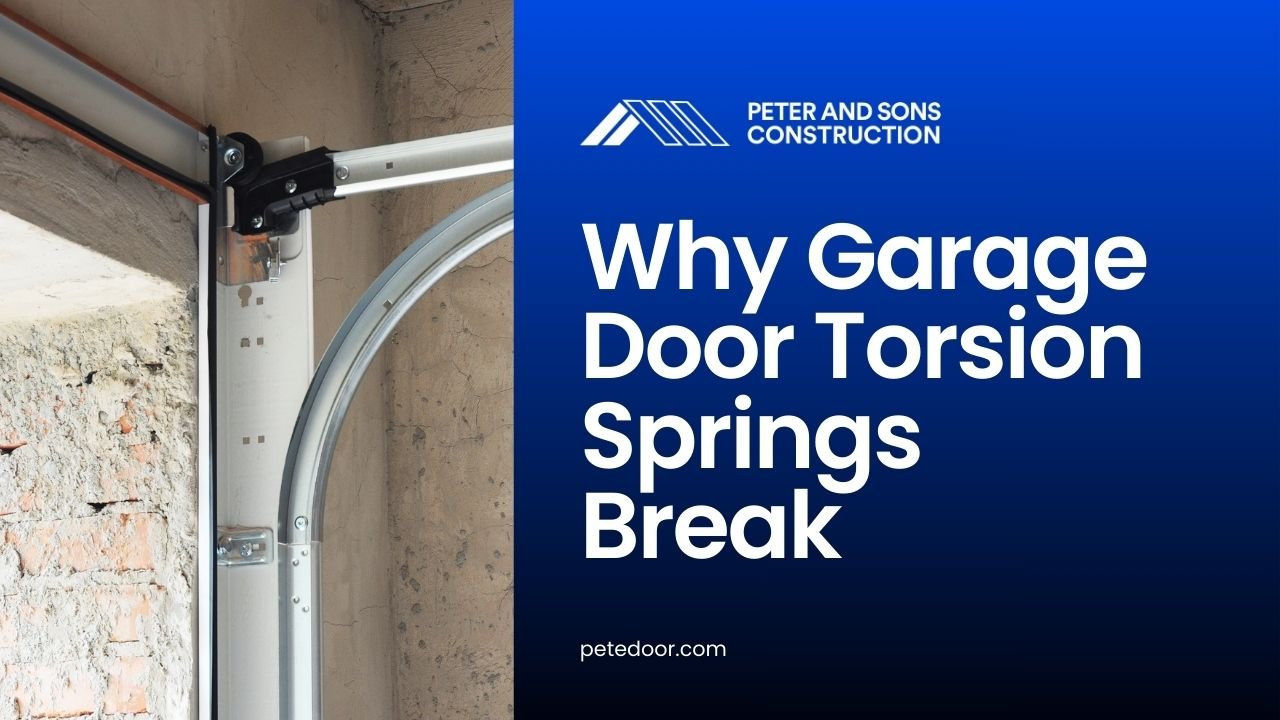Reasons Why Garage Door Torsion Springs Break and How to Prevent It
- Editorial Team
- January 31, 2025
- 4:22 am

A garage door torsion spring plays a crucial role in ensuring your garage door operates smoothly.
When it breaks, it can cause frustration and even safety concerns.
Learning the common reasons for these springs to fail and how to maintain them can save you time, money, and unnecessary hassle.
Here’s what you need to know to keep your garage door in great shape.
Common Causes of Torsion Spring Failure
1. Wear and Tear Over Time
The most common reason a garage door torsion spring breaks is simple wear and tear.
These springs are designed to last a specific number of cycles, with one cycle consisting of the door opening and closing once.
On average, torsion springs are built for 10,000 cycles. Depending on how often you use your garage, this lifespan can vary from a few years to a decade.
Once the spring exceeds its cycle limit, it weakens and eventually snaps.
Regularly monitoring the condition of your spring can help you address issues before they lead to a complete failure.
2. Rust Formation
When rust builds up on the spring, it increases friction during operation and weakens the metal.
This added stress can lead to premature breakage.
To prevent rust, consider applying a lubricant specifically designed for garage doors.
This simple step can significantly extend the life of your torsion spring.
3. Improper Installation
If a garage door torsion spring is not installed correctly, it may not function as intended. Uneven tension or misaligned components can place unnecessary stress on the spring, causing it to wear out faster.
Always rely on a professional to install or replace torsion springs to ensure they’re set up properly.
4. Extreme Temperature Changes
Sudden shifts in temperature can affect the metal in a torsion spring, causing it to expand and contract.
Over time, this constant fluctuation weakens the spring. If you live in an area with extreme weather conditions, this could be a contributing factor to premature spring failure.
Keeping your garage insulated can help reduce the impact of temperature changes on the spring, extending its lifespan.
5. Lack of Maintenance
Neglecting routine maintenance is a common reason to fail.
Without regular lubrication and inspections, wear and tear can go unnoticed, leading to sudden breakage.
Taking the time to perform simple upkeep tasks can make a significant difference.
How to Prevent Torsion Spring Issues
1. Schedule Regular Inspections
Inspect your garage door system, including the torsion spring, at least once a year. Look for signs of wear, rust, or misalignment. If you notice any issues, address them promptly to avoid further damage.
2. Lubricate the Springs
Use a high-quality lubricant to keep your garage door torsion spring operating smoothly. This reduces friction and prevents rust from forming. Apply the lubricant every three to six months for optimal results.
3. Limit Excessive Usage
If possible, minimize the number of times you open and close your garage door each day. Reducing the number of cycles can help prolong the lifespan of the torsion spring.
4. Replace Springs in Pairs
When one torsion spring breaks, it’s often a sign that the other spring is nearing the end of its lifespan as well. Replacing both springs at the same time ensures balanced tension and prevents uneven wear.
5. Hire Professionals for Repairs
These springs are under high tension and require specialized tools and expertise. Always consult a professional for installation or repairs to ensure safety and proper function.
Additional Tips for Extending Spring Life
1. Inspect for Damage After Severe Weather
Storms and high winds can place additional stress on your garage door system.
After extreme weather, take a few moments to inspect the torsion spring for any visible signs of damage, such as cracks or gaps in the coils.
Addressing these issues promptly can prevent further complications.
2. Avoid DIY Repairs
While it may be tempting to save money through repairing your garage door yourself, the risks often outweigh the rewards.
Torsion springs are under immense tension, and mishandling them can lead to serious injuries.
Trusting a professional ensures the job is done safely and correctly.
3. Upgrade to High-Cycle Springs
If you use your garage door frequently, consider upgrading to high-cycle springs.
These springs are designed to last longer than standard ones, offering increased durability and fewer replacements over time. This upgrade can be a worthwhile investment for heavy garage door users.
4. Install a Safety Cable
A safety cable can help contain the spring in the event of a break. This added precaution minimizes the risk of injury or damage caused through a snapping spring.
Installing a safety cable is a cost-effective way to improve the overall safety of your garage door system.
5. Pay Attention to Warning Signs
Unusual noises, jerky movements, or an unevenly balanced door can all indicate issues with your torsion spring.
Addressing these warning signs early can prevent bigger problems down the road. Regular attention to these details can save you from expensive repairs later on.
Protect Your Garage Door with Expert Care
A garage door torsion spring is a small yet vital component of your garage door system.
Through learning the causes of spring failure and taking proactive steps to maintain it, you can avoid unexpected breakdowns and costly repairs.
At Peter and Sons Construction, we specialize in providing reliable garage door services, from inspections to repairs and replacements.
Visit us at Peter and Sons Construction to learn more about how we can assist you in keeping your garage door in top condition.
We’re here to help you protect your investment with expert care. Our team is dedicated to ensuring your garage door operates smoothly and safely for years to come.



